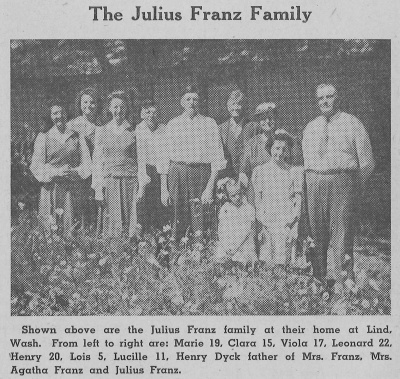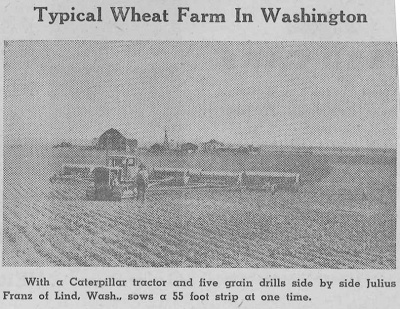If this site was useful to you, we'd be happy for a small donation. Be sure to enter "MLA donation" in the Comments box.
Franz, Julius Albert (1899-1956)
Mennonite Weekly Review obituary: 1956 May 3 p. 6
Birth date: 1899 Jun 13
text of obituary:
. . .
— Word has been received of the death of Julius Franz, 57, well known farmer of the Lind, Wash. community, who died Tuesday evening at a Spokane hospital. Lois Franz, freshman at Bethel College, left to attend her father's funeral.
Mennonite Weekly Review obituary: 1956 May 17 p. 8
text of obituary:
JULIUS A. FRANZ
Julius Albert Franz, son of Leonard L. and Julianna Ewert Franz, was born June 13, 1899, near Marion, South Dakota, and departed this life to be with his Lord and Savior whom he dearly loved and served the evening of May 1, 1956, after a three month illness, at the age of 56 years, 10 and one-half months.
In 1902 he moved with is parents to Washington, pioneering in the Schrag area where he farmed until his death.
He was baptized April 2, 1915, and received into the fellowship of the Menno Mennonite Church where he remaind [sic] a faithful and active member during his life of service on this earth. he served several terms as deacon, was a Sunday School teacher many years and was active in conference and resettlement work.
He was married to Agatha Dyck on Sept. 4, 1919, and this union was blessed with nine children, two sons, leonard H. and Henry J. of Lind, and seven daughters, Mrs. Marie Ewert, Marion, South Dakota, Mrs. Viola Boese, Bellingham, Wash., Mrs. Clara Reimer, Lind, Mrs. Lucille Harms, Kansas City, Kansas, Lois and Judy at home. One daughter preceded him in death.
Also surviving are seven grandchildren, one sister, Mrs. Rudolph Claassen of lacrosse, Wash., and three brothers, Edward, Santa Monica, Calif., Arthur and Robert, Lind, many aunts and uncles and other relatives.
We children will never cease to be grateful for the Christian home daddy and mother made for us and the principles and ideals which were his will always be a challenge to us. He can say with the apostle Paul, "I hve fought a good fight, I have finished my course, I have kept the faith; Henceforth there is laid up for me a crown of righteousness which the Lord, the righteous judge shall give me at that day; and not to me only, but unto all them also that lvoe his appearing." — The Children.
Mennonite Weekly Review obituary: 1943 Feb 11 p. 4
text of biography:
The Story Of A Mennonite Wheat Farming Family In The Great Northwest
Editor’s note: This is another of a series of biographical sketches of Mennonite farmers who are also family men, church and community leaders. The purpose of these sketches is not to exalt the individual farmer unduly but rather to tell a human interest story about representative Mennonite families and the way they make a living in different parts of the world. — J. W. F.
Mr. and Mrs. Julius Franz of Lind, Washington, are both natives of the Middle West. Mrs. Franz is the daughter of Henry and Maria Dyck who came to America from Germany in the 1870's and settled in Beatrice, Nebraska. In 1902 the Dycks sold their small farm and with two car loads of horses, cows and farming equipment moved to a homestead 25 miles west of Ritzville in the state of Washington. Mrs. Franz grew up in this community.
The parents of Mr. Franz were Leonard and Julianna Franz both natives of South Dakota. In the fall of 1902 they too sold their farm and moved from Dolton, South Dakota to a homestead 23 miles west of Lind. Both families affiliated with the Menno Mennonite Church at Lind which was organized in 1898.
For the first ten years of the church’s existence the meetings were held in a school house. Mr. Franz remembers vividly how the family used to drive the sixteen miles from home to church with a team and a two seated buggy. In later years his parents sold the homestead and moved seven miles closer to the church and to the town of Lind and built up the home on which the Franz’s now live.
Among the incentives for coming west were the mild climate, the homestead grants, and the cheap railroad lands. When the railroads first built their roads through the Pacific coast the government granted them one half of the land twenty miles on both sides of the railroad.
The railroads in turn sold the land to the settlers. The prices ranged from fifty cents to two-dollars and fifty cents an acre. All of the land was unimproved. The sage brush was cleared with rails borrowed from the railroad companies and during the early years served as the sole fuel supply. Mr. Franz believes that the sagebrush was superior as a fuel to the corn cobs frequently used in the Middle West.
Mr. and Mrs. Franz were married on September 4, 1919 and began farming for themselves on a rented farm in the fall of 1922. These were hard years for the farmer and this young married couple was put to a severe test during these post-war depression years. Their chief asset, said Mr. Franz, was a will to work. Not until more recent times have they been able to “get ahead” in the economic sense.
While fortune may not have smiled on this family from the beginning in a material way it did smile on them in other more important ways. The Lord blessed the family with seven children all of which are deeply attached to their home and parents. All who know this family speak of the fine Christian spirit that is manifested in the Franz home.
This family is a generous and a jolly one but along with the fun that is found in a large family comes also the necessity of learning to share with others, to respect one another, and to assume one’s share of the work that needs to be done. These things seem to have been quite well learned by the Franz children.
Leonard, 22, and Henry, 20 , are at present still at home helping with the work on their large farm. The boys not only share in the work but also in the ownership of the livestock and in some of the other operations. If there ever was tyranny in this home there is no evidence of it today. things are done democratically.
When major maters of policy are to be determined a family council is called and things talked over. There may not always be 100% agreement but at least the members of the family know each other’s attitudes and sense the consensus of opinion.
Marie, 19, and Viola, 17, are at the present time first and second year students at Bethel College at North Newton, Kansas. Clara 15, Lucille, 11, and Lois 5 are all at home sharing with their parents in the life of the home, the church and the community.
At the present time the Franz’s own close to six thousand acres and rent an additional 640. this is extensive farming in the true sense. Not all farms in this area are this size but the average Mennonite farmer in the Lind community operates about four sections or about 2500 acres.
It should be remembered, however, that normally only half the acreage is in crop and the other half is in summer fallow. The rainfall in this area is only ten inches on the average for the year as compared to thirty-one inches at Newton, Kansas, or forty-one inches in Lancaster, Pennsylvania.
This means that it requires two years moisture to raise a single crop. That is the chief reason for leaving half of the ground fallow.
It is of interest to note how Mr. Franz and some of the other Mennonites around Lind came to farm on the large scale they now do. during the hard years many of the settlers became discouraged and sought more fertile pastures.
This left a good many untilled farms. With the coming of the diesel track-laying tractors and other new types of machinery this deserted land was added to the existing farms by means of lease or purchase, making some rather large farming units.
On Mr. Franz’s farm, for example, there are six drilled wells which all represent what were once individual building sites. Three of these wells are not being used at the present time.
Wheat is the main crop raised but not the only one. During the past year Mr. Franz and his sons had 2200 acres in wheat and 560 acres distributed between barley, rye and oats, and about 600 acres of crested wheat grass diversion under the Government program for pasture. Over a ten year period the average yield per acre was between 8 and 12 bushels but during the past two years the Lord showered unusual blessings upon them so that the wheat yielded from 30 to 35 and even 40 bushels in some cases.
During harvest season on the Franz farm two combine harvesters are operated. Together they cut a swath 44 feet wide. These machines are pulled separately by two caterpillar diesal [sic] tractors: one an RD6 and the other an RF7. All of the grain is handled in bulk.
The combines are equipped with grain tanks which hold about 150 bushels together. The grain is moved by truck from the combines to the storage bins which were erected this year in the fields with rough boarding and then covered with straw. On this farm the total grain crop amounted to over 80,000 bushels during the past year.
To make the best use of the Government farm program, Mr. Franz has built up a herd of about 90 head of cattle and about 150 hogs. Wheat that is spoiled is fed to the hogs, thus preventing waste. The main market for farmers sin the Lind community is at Spokane about 95 miles to the northwest. Very few vegetables and practically no fruits or berries are raised in this community due to the low humidity. Water for the cattle has to be pumped and this sometimes to a depth of 400 feet.
Those who have read about the highly advertised Coulee Dam will be interested to know that bout half of Mr. Franz’s land is scheduled eventually to come under water. He does not expect it to come soon, however, because there is still approximately 2,000,000 acres not now under cultivation that will be fertilized first.
With the exception of two years Mr. Franz has always complied with the AAA program. He has frequently disagreed with the Fede3ral Government policies but he thinks the soil conservation and crop price control ventures and the attempt to organize farmers is desirable.
There are at the present time about forty resident families who are members of the Lind Mennonite church. About ten of these families live in [end of article in paper]


